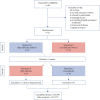The effect of high altitude (2500 m) on incremental cycling exercise in patients with pulmonary arterial hypertension and chronic thromboembolic pulmonary hypertension: a randomised controlled crossover trial
- PMID: 38423623
- PMCID: PMC10918318
- DOI: 10.1183/13993003.01001-2023
The effect of high altitude (2500 m) on incremental cycling exercise in patients with pulmonary arterial hypertension and chronic thromboembolic pulmonary hypertension: a randomised controlled crossover trial
Abstract
Background: Our objective was to investigate the effect of a day-long exposure to high altitude on peak exercise capacity and safety in stable patients with pulmonary arterial hypertension (PAH) and chronic thromboembolic pulmonary hypertension (CTEPH).
Methods: In a randomised controlled crossover trial, stable patients with PAH or distal CTEPH without resting hypoxaemia at low altitude performed two incremental exercise tests to exhaustion: one after 3-5 h at high altitude (2500 m) and one at low altitude (470 m).
Results: In 27 patients with PAH/CTEPH (44% females, mean±sd age 62±14 years), maximal work rate was 110±64 W at 2500 m and 123±64 W at 470 m (-11%, 95% CI -16- -11%; p<0.001). Oxygen saturation measured by pulse oximetry and arterial oxygen tension at end-exercise were 83±6% versus 91±6% and 6.1±1.9 versus 8.6±1.9 kPa (-8% and -29%; both p<0.001) at 2500 versus 470 m, respectively. Maximal oxygen uptake was 17.8±7.5 L·min-1·kg-1 at high altitude versus 20±7.4 L·min-1·kg-1 at low altitude (-11%; p<0.001). At end-exercise, the ventilatory equivalent for carbon dioxide was 43±9 at 2500 m versus 39±9 at 470 m (9%, 95% CI 2-6%; p=0.002). No adverse events occurred during or after exercise.
Conclusions: Among predominantly low-risk patients with stable PAH/CTEPH, cycling exercise during the first day at 2500 m was well tolerated, but peak exercise capacity, blood oxygenation and ventilatory efficiency were lower compared with 470 m.
Copyright ©The authors 2024.
Conflict of interest statement
Conflict of interest: None of the authors have any conflicts of interest in relation to this manuscript.
Figures


Comment in
-
High altitude travelling with pulmonary arterial hypertension.Eur Respir J. 2024 Mar 7;63(3):2400111. doi: 10.1183/13993003.00111-2024. Print 2024 Mar. Eur Respir J. 2024. PMID: 38453244 No abstract available.
References
Publication types
MeSH terms
Substances
LinkOut - more resources
Full Text Sources
Medical
Miscellaneous
